What if students not only had opportunities to learn about climate change at school, but were also empowered to take action in their local communities?
What if students had the chance to co-develop the tools needed to create and implement real climate solutions?
What if students had the opportunity to be recognized for their work in responding to climate change, so that they are more prepared to bring climate literacy skills to their post-secondary opportunities across all sectors?
The Seal of Climate Literacy has done just that.
About the Seal of Climate Literacy: A Brief History
Since the Seal of Climate Literacy Diploma Endorsement was created by Senate Bill 24-014 and signed into law by Governor of Colorado Jared Polis in May of 2024, it has already made its way into the hands of hundreds of students, educators, and district leaders, impacting communities across the state just one year later. The Seal of Climate Literacy is more than a diploma endorsement - it’s the beginning of a movement to empower youth in public schools to learn about climate change and embolden them to take action.

The Seal of Climate Literacy differs from many state education policies, as it was created through the input of diverse and inclusive community voices and intentionally designed to be adaptable, allowing local communities to tailor it to their unique values and needs. The Seal of Climate Literacy is voluntary, not mandated, meaning that Local Education Providers (LEPs) such as school districts, charter networks, individual schools, and Boards of Cooperative Educational Services (BOCES) opt-in.
Lyra, an education non-profit organization, initiated and continues to support the Seal of Climate Literacy. Lyra wanted this new education policy not to tell LEPs what to do and how to do it - but to create a way for LEPs to better meet the needs of their students in a way that is deeply informed by local community values.
“I feel like people will actually hear us now,” said Rhyianna Banks, a senior whose community was devastated by hurricanes before she moved to Colorado. “We are learning how to be heard.”
The Summit offered more than inspiration—it provided tools. Students learned how to assess local climate vulnerabilities, build coalitions, and speak confidently with decision-makers. They were encouraged to see themselves as both change agents and collaborators—able to build a better future not alone, but together.
Requirements of the Seal of Climate Literacy
In order to be conferred the Seal of Climate Literacy, students must meet minimum high school graduation requirements, successfully complete two courses with climate literacy principles including one science course, and complete a hands-on experiential learning project in the community that they share about with a greater audience.
The requirements are intentionally broad, as the legislation seeks to give as much autonomy to LEPs as possible. LEPs determine the high school graduation requirements, the climate literacy principles, and the specific courses that quality students for the Seal. Additionally, LEPs also create the specific requirements for experiential learning projects and oversee their execution in collaboration with various community partners.
The Seal of Climate Literacy in Year 1
While more detailed implementation data will be available in late 2025 from the Colorado Department of Education, Lyra is committed to sharing what we know relationally - that is, from working in collaboration with multiple LEPs conferring the Seal of Climate Literacy.
Lyra has led a campaign to support the implementation of the Seal in its first year by offering technical support, mini-grants, and in-kind materials to 14 LEPs. Through these relationships, Lyra has captured learnings about implementation challenges and opportunities with the intention of uplifting them to better support current and future implementers.
The Seal of Climate Literacy is being conferred in diverse regions across the state of Colorado, including in rural and urban areas. It’s in high demand from students - approximately 423 students have been conferred the Seal of Climate Literacy in its first full year as a state law.
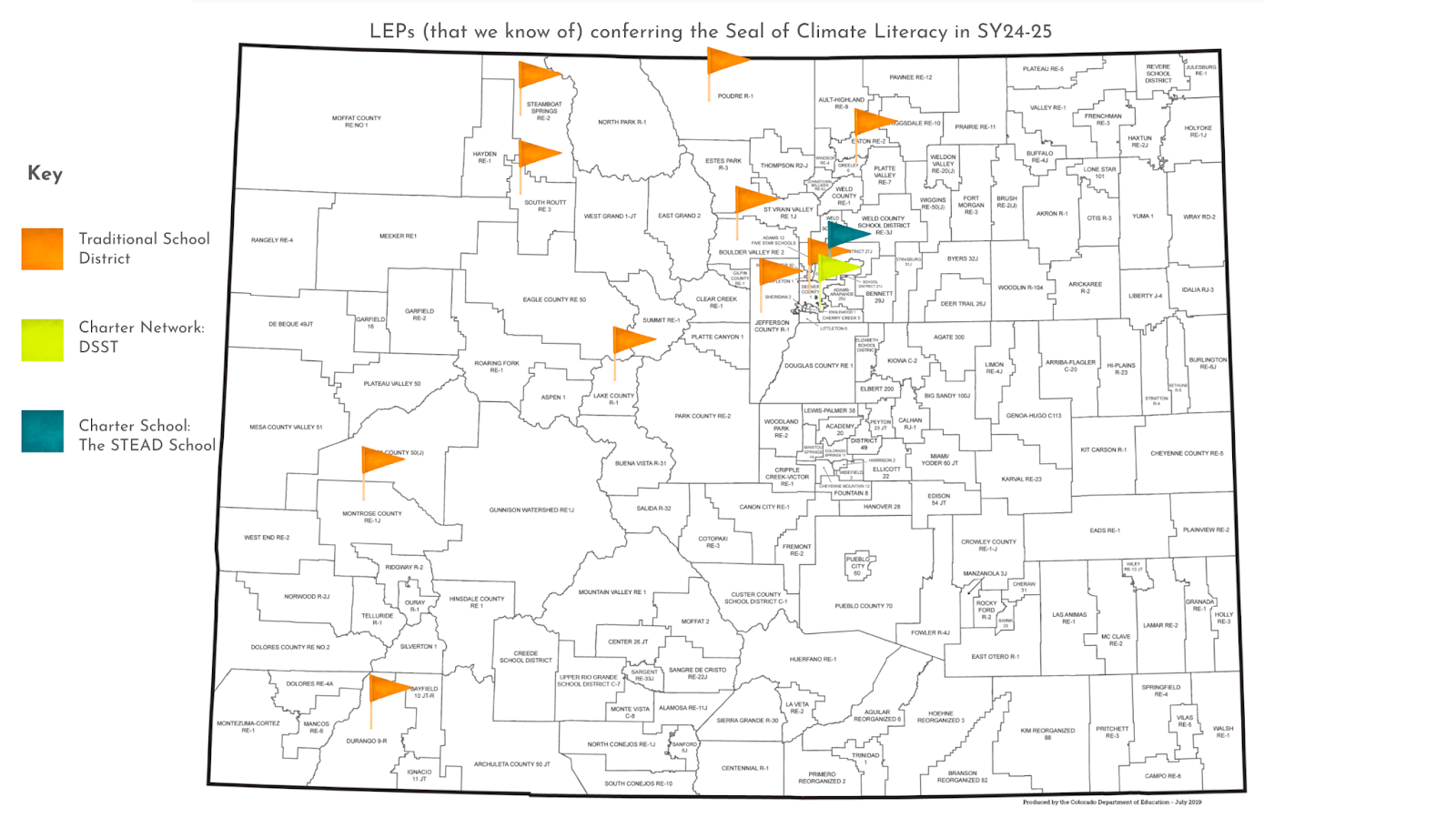
LEPs implementing the Seal of Climate Literacy in School Year 2024-2025 include Alameda High School of Jefferson County Public Schools, Boulder Valley School District, Denver Public Schools, DSST: Cedar, Durango School District, Jefferson County Public Schools, Lake County School District, Montrose County School District, Poudre School District, Rocky Mountain High School of Poudre School District, Steamboat Springs School District, South Routt School District, The STEAD School, and Weld (Greeley-Evans) District 6.
There is no one-size-fits-all approach to implementing the Seal of Climate Literacy; each LEP listed above has implemented the Seal differently, in ways that reflect the community’s own values. Additionally, there are strengths to large urban and small rural school systems. Smaller or more rural school systems may benefit from closer student connections, while larger or more urban school systems may benefit from having more staff - both offering benefits for implementation.
Implementation Success Stories from Across Colorado
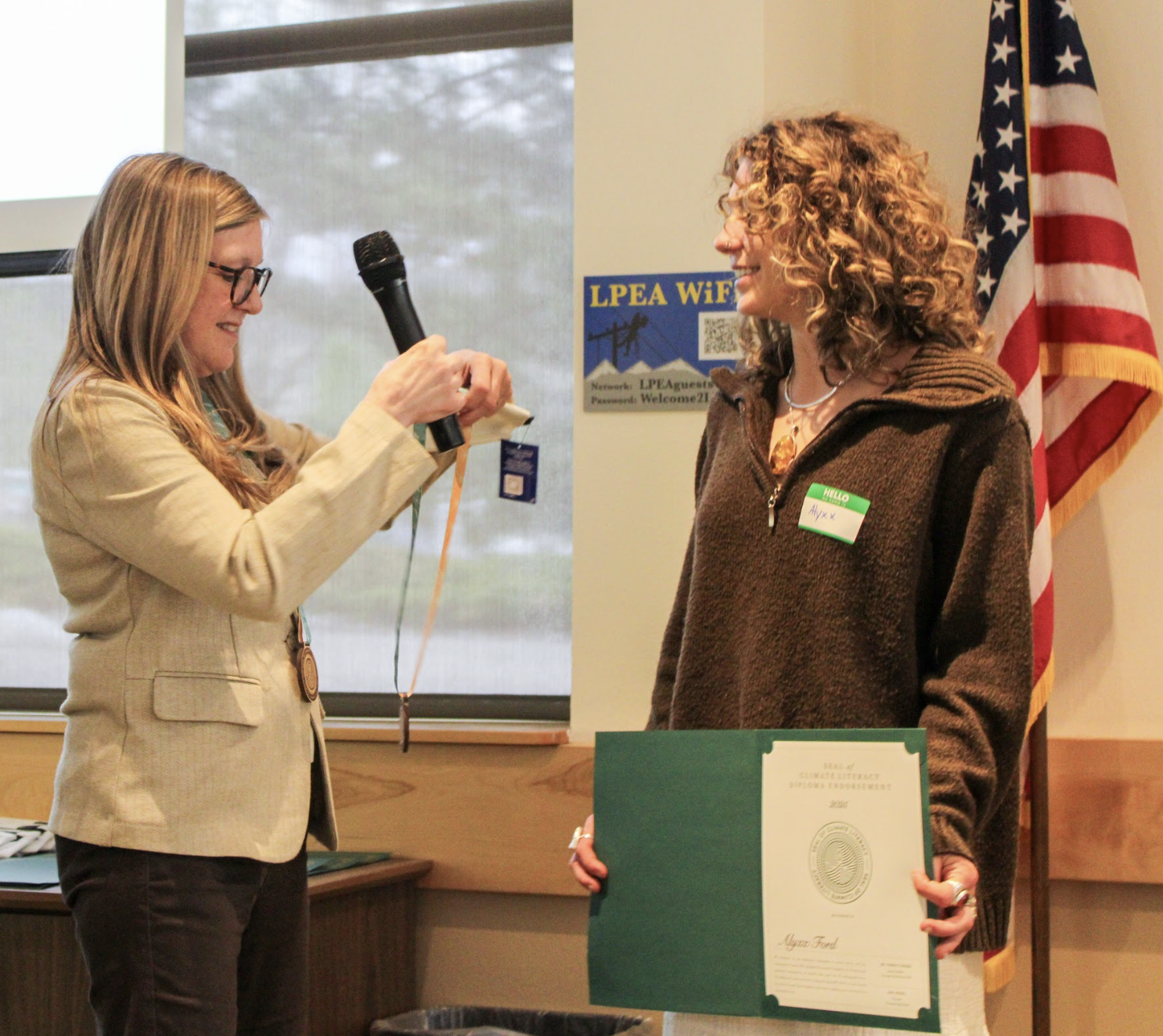
Durango School District 9-R, under the leadership of Superintendent Karen Cheser, conferred the Seal of Climate Literacy to sixteen students just days after it was signed into law in 2024, becoming the first district in the state to confer the Seal of Climate Literacy and the only district to confer it that school year. Dr. Cheser credits their quick implementation of the Seal to Durango’s existing strong alignment with climate literacy principles and project-based learning. Notably, Durango is the only district that Lyra knows of at the time of this publication that is implementing the Seal without mini-grant funding from Lyra, demonstrating that it can be implemented without external funding resources. Dr. Cheser urges other school district leaders to implement the Seal, stating “The Seal sends a message that our students are making an impact and are passionate about being the agents of change. If our students can benefit now, why wait?” Learn more about Durango’s implementation process and lessons learned in this case study.
Lake County School District, a small rural district in Leadville, has implemented the Seal through educators’ close connections with students and through a partnership with Colorado Mountain College, a higher education institution that offers courses to high school students in various subjects, some of which align with the district’s climate literacy standards. Drawing on her strong relationships with students, Lake County High School educator Nicci Condon quickly identified those who might be interested in the Seal and encouraged them to pursue it. For Nicci, the students pursuing the Seal give her hope, stating, “It’s hard to remember to not lose hope when climate change is such a big issue, but students definitely give me hope for young people, our community, and what our world could be.”
Steamboat Springs School District has connected the Seal with climate issues facing the community. According to Bennett Colvin, a science teacher at Steamboat Springs High School, it is becoming increasingly difficult to grow crops in the community due to its high elevation, variations in temperatures, and adverse soil conditions. As such, the community relies on crops being trucked in from all over the state and country, which increases carbon emissions and makes the available produce less fresh and nutritious. Bennett and his students are on a mission to solve this problem by growing crops in a hydroponics lab at the school. Not only does this empower students to learn about climate change at school, it allows them to take immediate action while having a measurable impact on the local community. Using the mini-grant provided by Lyra as seed funding, Bennett looked to the community to contribute donations. The support of a matching donation allowed him to double his resources and improve the lab.
Boulder Valley School District has implemented the Seal with the most rigorous requirements in the state so far. The district awarded the Seal to 20 students across nine high schools. In order to earn the Seal, BVSD students must complete an application requiring them to connect a local climate problem to at least five climate learning experiences from grades 6-12 to climate literacy standards. The legislation requires that students complete one experiential learning project to be conferred the Seal, but BVSD requires a minimum of five - a reflection of their desire for students to understand climate change as a problem that has not just one solution, but many. From there, each student’s application is reviewed by a committee of district leaders, Green Youth Council members (including middle and high school students), and community members. The application review team decides if a student’s application is complete or not, and provides feedback to help students improve their applications before its final consideration. Learn more about Boulder’s implementation process in this blog post.
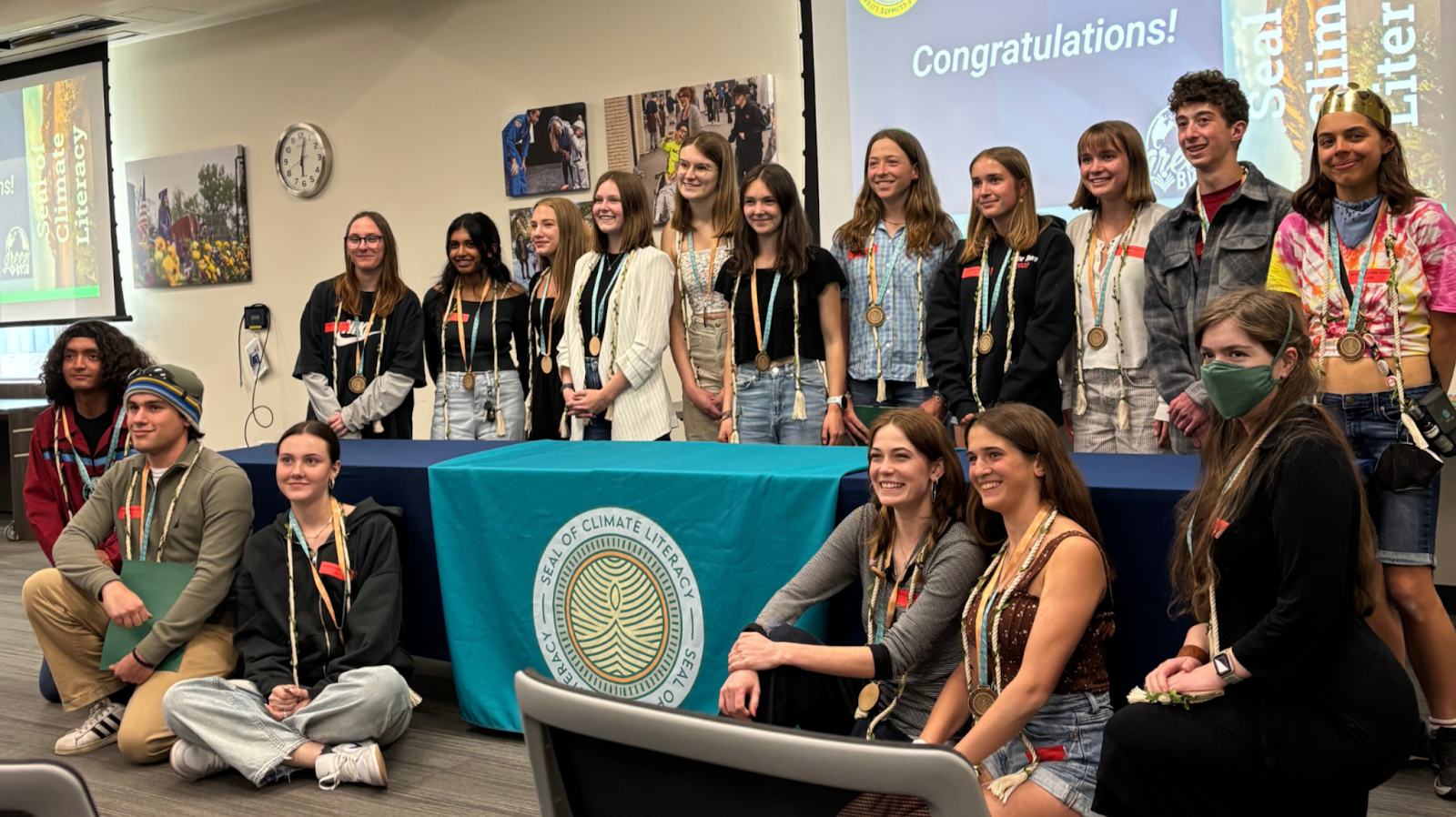
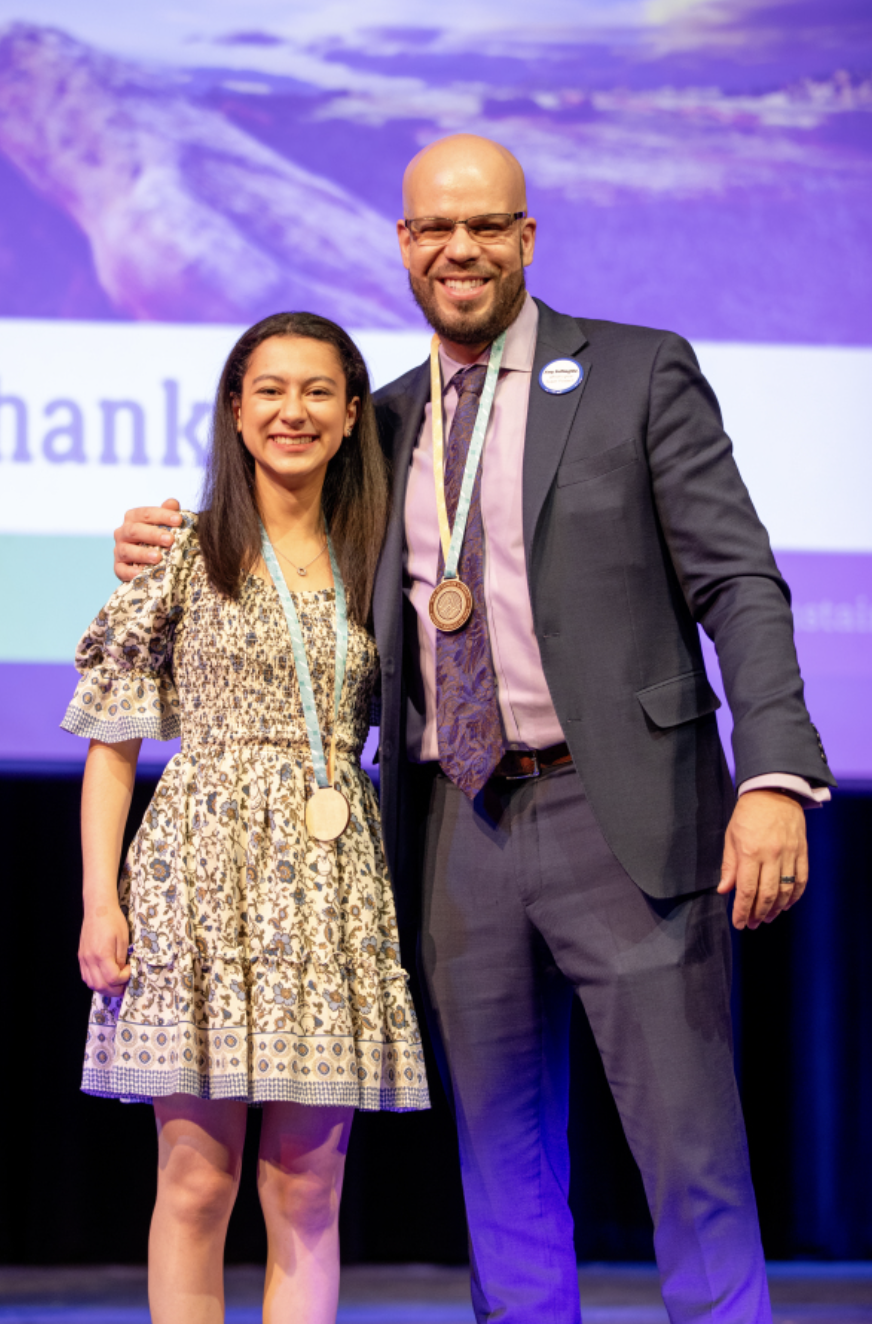
Denver Public Schools, the largest district in Colorado, awarded the Seal to 171 students - the highest number in the state - accounting for one-third of all students who received the Seal statewide. This was possible because DPS centralized implementation at the district level, and had consistent support at all levels of the school system. DPS appointed someone at each school site to be the point of contact between students and the DPS Sustainability Team, the team leading the implementation of the Seal. Because of this role, it was possible to streamline communication and resources about the Seal, ensuring that information about requirements and deadlines were accessible to all students. Superintendent Alex Marrero is a strong advocate of the Seal, stating that “The Seal of Climate Literacy equips students with the knowledge, skills, and confidence to address climate challenges. It allows them to pursue careers in sustainability, and become productive members of their local and global societies.”
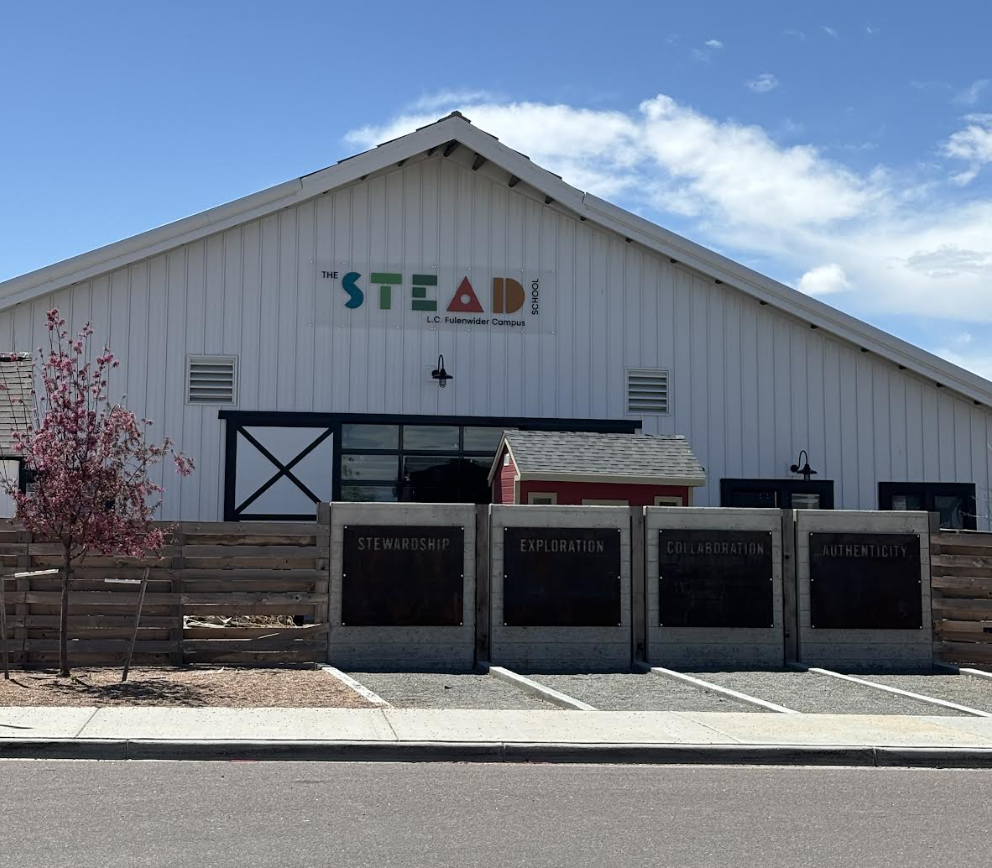
The STEAD School, an individual charter school located in Commerce City, emphasizes hands-on learning experiences for students with a focus on agriculture. Due to its existing focus on agriculture - including the stewardship of land, animals, and resources - the school was able to confer the Seal of Climate Literacy to every graduating senior, amounting to over 100 students. This sets a strong example of how LEPs can maximize student attainment of the Seal, as instead of having students individually apply for the Seal, The STEAD School embedded the Seal into an existing learning pathway. Additionally, The STEAD School considered opportunities for students to cultivate durable skills through their experiential learning projects by having students pitch their project ideas (including a detailed budget proposal - made possible through the mini-grant from Lyra) to the community, receiving feedback that ultimately shaped how each project was funded.
The above LEPs represent just a handful of implementation success stories - there were many more across the state. To learn more about implementation opportunities, challenges, and things to consider - informed by Lyra’s close relationships with LEPs implementing the Seal - view this report.
What are some examples of student projects?
Per the legislation, LEPs are required to report information about students’ experiential learning projects and community partnerships to the Colorado Department of Education, and a detailed report will be available this Fall. When it is possible, Lyra will collect and share information about community organizations that are supporting students with their experiential learning projects. The team at Lyra was fortunate to see some students’ projects in action - including at community exhibitions and graduation ceremonies, with a few highlights included below.
Many LEPs across the state, including Alameda International Junior/Senior High School of Jefferson County Public Schools and PEAK Academy of Montrose County School District, partner with River Watch of Colorado to monitor water quality and other indicators of watershed health and utilize this data to inform communities and decision-makers about the condition of water in Colorado. One student at Alameda International, Hilary, not only participated in the program - she went above and beyond to translate the pages of the lab results into Spanish so that more people could understand them and participate.
Students in various communities participated in research on wildfire mitigation, water quality, and forestry, just to name a few. Others participated in district and school wide sustainability initiatives, such as solar installations, programs that aim to reduce food waste, compositing programs, and more.
Experiential learning projects often extend beyond scientific research or sustainability efforts. Many students have creatively connected their learnings about climate change to a wide range of interests - from policy advocacy and sports venues to sustainable fashion, and many more. Read more about some of these projects in this blog post.
What's next?
Lyra launched a second-year of mini-grant funding, intending to award new LEPs between $1,000 and $5,000 to kick-start the implementation of the Seal of Climate Literacy. Additionally, Lyra intends to award existing grantees from Year 1 with mini-grant funding for their work to deepen the impact of the Seal across one of four categories:
- Reaching more diverse student populations
- Expanding number of students attaining the Seal by 3x Year 1 based on key learnings
- Exploring Seal of Climate Literacy alignment outside of traditional science courses
- Partnerships with community partners to deepen experiential learning opportunities
In addition to mini-grant funding, Lyra offers technical support to LEPs across the state to help support the implementation of the Seal. Our close relationships with school systems across the state have given us a birds eye view of how the Seal is taking shape in various contexts, and we want to use this highly valuable knowledge to support school systems at all stages of implementing the Seal - ranging from those who are curious to learn more to those who are refining their process for a second year. Likewise, Lyra has offered in-kind materials to recognize students who earn the Seal, including medals, certificates, and other pieces of swag.
Stay tuned for more on the successes and learnings through seal implementation around the state and reach out if you would like to learn more or engage more deeply with us in this work.








